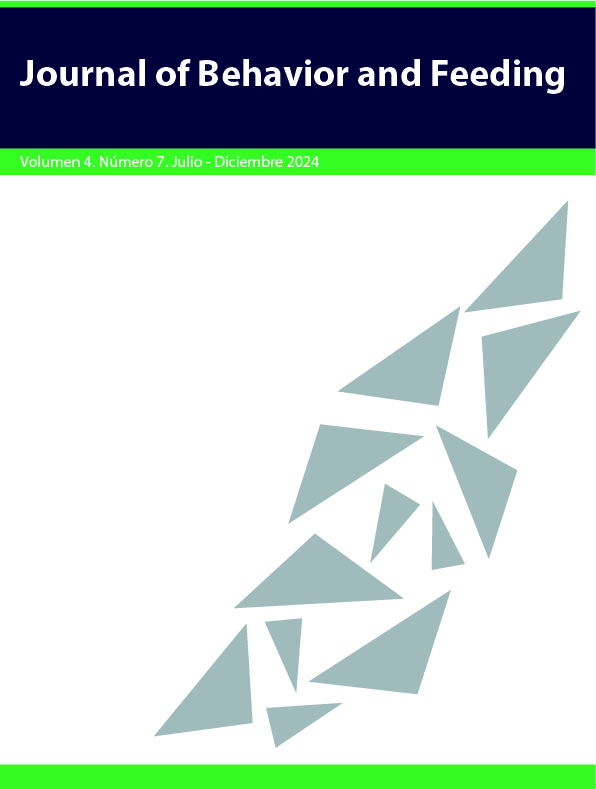El rol del azúcar y los edulcorantes en la adicción a la comida: una mirada desde la neurociencia
DOI:
https://doi.org/10.32870/jbf.v4i7.59Palabras clave:
Adicción a la comida, Neurociencia de la alimentación, AzúcaresResumen
Obesidad y adicción a la comida son un problema emergente de salud pública en el mundo. La adicción a la comida es una propuesta teórica con importantes apoyos experimentales y clínicos. El presente artículo aborda evidencias sobre la adicción a la comida, así como sus bases neurobiológicas y los efectos sobre la plasticidad cerebral tras el consumo de azúcares. Este trabajo se presenta como una perspectiva para puntualizar sobre la capacidad de los alimentos ricos en azúcares para estimular los sistemas de recompensa y ahondar sobre un modelo de adicción a los azúcares, que pueda ser utilizado en investigaciones a nivel preclínico.
Descargas
Citas
Adams, W. K., Sussman, J. L., Kaur, S., D’souza, A. M., Kieffer, T. J., y Winstanley, C. A. (2015). Long-term, calorie-restricted intake of a high-fat diet in rats reduces impulse control and ventral striatal D2 receptor signalling – two markers of addiction vulnerability. European Journal of Neuroscience, 42(12), 3095-3104. https://doi.org/10.1111/ejn.13117
Ahmed, S., Guillem, K., y Vandaele, Y. (2013). Sugar addiction: pushing the drug-sugar analogy to the limit. Current Opinion in Clinical Nutrition & Metabolic Care, 16(4), 434-439. https://doi.org/10.1097/MCO.0b013e328361c8b8.
Alsiö, J., Olszewski, P. K., Norbäck, A. H., Gunnarsson, Z. E. A., Levine, A. S., Pickering, C., y Schiöth, H. B. (2010). Dopamine D1 receptor gene expression decreases in the nucleus accumbens upon long-term exposure to palatable food and differs depending on diet-induced obesity phenotype in rats. Neuroscience, 171(3), 779-787. https://doi.org/10.1016/j.neuroscience.2010.09.046
Aoyama, K., Barnes, J., y Grimm, J. W. (2014). Incubation of saccharin craving and within-session changes in responding for a cue previously associated with saccharin. Appetite, 72, 114-122. https://doi.org/10.1016/j.appet.2013.10.003
Ashok, I., Sheeladevi, R., y Wankhar, D. (2013). Long term effect of aspartame (Artificial sweetener) on membrane homeostatic imbalance and histopathology in the rat brain. Free Radicals and Antioxidants, 3, S42-S49. https://doi.org/10.1016/j.fra.2013.09.003
Avena, N. M. (2010). The study of food addiction using animal models of binge eating. Appetite, 55(3), 734-737. https://doi.org/10.1016/j.appet.2010.09.010
Avena, N. M., y Hoebel, B. G. (2003). A diet promoting sugar dependency causes behavioral cross-sensitization to low dose of amphetamine. Neuroscience, 122. 17-20. https://doi.org/10.1016/S0306-4522(03)00502-5.
Avena, N.M., Bocarsly, M.E., y Hoebel, B.G. (2012). Animal models of sugar and fat bingeing: relationship to food addiction and increased body weight. En: F. H. Kobeissy (Ed.) Psychiatric Disorders. Methods and Protocols. Humana Press. https://doi.org/10.1007/978-1-61779-458-2_23
Avena, N. M., Long, K. A., y Hoebel, B. G. (2005). Sugar-dependent rats show enhanced responding for sugar after abstinence: evidence of a sugar deprivation effect. Physiology & Behavior, 84(4), 359-362. https://doi.org/10.1016/j.physbeh.2004.12.016.
Avena, N. M., Rada, P., Moise, N., y Hoebel, B. G. (2006). Sucrose sham feeding on a binge schedule releases accumbens dopamine repeatedly and eliminates the acetylcholine satiety response. Neuroscience, 139, 813-820. https://doi.org/10.1016/j.neuroscience.2005.12.037
Avena, N. M., Rada, P., y Hoebel, B. G. (2008). Evidence for sugar addiction: Behavioral and neurochemical effects of intermittent, excessive sugar intake. Neuroscience & Biobehavioral Reviews, 32(1), 20-39. https://doi.org/10.1016/j.neubiorev.2007.04.019
Bello, N. T., Lucas, L. R., y Hajnal, A. (2002). Repeated sucrose access influences dopamine D2 receptor density in the striatum. NeuroReport, 13(12), 1575.
Benton, D. (2010). The plausibility of sugar addiction and its role in obesity and eating disorders. Clinical Nutrition, 29, 288-303. https://doi.org/10.1016/j.clnu.2009.12.001.
Berridge, K. C., y Robinson, T. E. (2003). Parsing reward. Trends in Neurosciences, 26(9), 507-513. https://doi.org/10.1016/S0166-2236(03)00233-9
Blass, E. M., Ganchrow, J. R., y Steiner, J. E. (1984). Classical conditioning in newborn humans 2-48 hours of age. Infant Behavior and Development, 7(2), 223-235. https://doi.org/10.1016/S0163-6383(84)80060-0
Bocarsly, M.E., y Avena, N.M. (2020). Animal models of binge-eating palatable foods: Emergence of addiction-like behaviors and brain changes in the rat. En: Avena, N.M. (Ed.) Animal Models of Eating Disorders. Humana Press. https://doi.org/10.1007/978-1-0716-0924-8_10
Boutelle, K. N., Wierenga, C. E., Bischoff-Grethe, A., Melrose, A. J., Grenesko-Stevens, E., Paulus, M. P., y Kaye, W. H. (2015). Increased brain response to appetitive tastes in the insula and amygdala in obese compared with healthy weight children when sated. International Journal of Obesity, 39(4), 620-628. https://doi.org/10.1038/ijo.2014.206
Brunault, P., Courtois, R., Gearhardt, A. N., Gaillard, P., Journiac, K., Cathelain, S., Réveillère, C., y Ballon, N. (2017). Validation of the French version of the DSM-5 Yale Food Addiction Scale in a nonclinical sample. The Canadian Journal of Psychiatry, 62(3), 199-210. https://doi.org/10.1177/0706743716673320
Camacho, A., Montalvo-Martinez, L., Cardenas-Perez, R. E., Fuentes-Mera, L., y Garza-Ocañas, L. (2017). Obesogenic diet intake during pregnancy programs aberrant synaptic plasticity and addiction-like behavior to a palatable food in offspring. Behavioural Brain Research, 330, 46-55. https://doi.org/10.1016/j.bbr.2017.05.014
Cantin, L., Lenoir, M., Augeir, E., Vanhille, N., Dubreucq, S., Serre, F., Vouillac, C., y Ahmed, S. H. (2010). Cocaine is low on the value ladder of rats: possible evidence for resilience to addiction. PLOS ONE, 5(7), 1-14. https://doi.org/10.1371/journal.pone.0011592
Colantuoni, C., Rada, P., McCarthy, J., Patten, C., Avena, N. M., Chadeayne, A., y Hoebel, B. G. (2002). Evidence that intermittent, excessive sugar intake causes endogenous opioid dependence. Obesity Research, 10(6), 478-488. https://doi.org/10.1038/oby.2002.66
Colantuoni, C., Schwenker, J., McCarthy, J., Rada, P., Ladenheim, B., Cadet, J. L., Schwartz, G. J., Moran, T. H., y Hoebel, B. G. (2001). Excessive sugar intake alters binding to dopamine and mu-opioid receptors in the brain. Neuroreport, 12(16), 3549-3552.
Corsica, J. A., y Pelchat, M. L. (2010). Food addiction: True or false? Current Opinion in Gastroenterology, 26(2), 165. https://doi.org/10.1097/MOG.0b013e328336528d
Costanzo, A., Nowson, C., Orellana, L., Bolhuis, D., Duesing, K., y Keast, R. (2018). Effect of dietary fat intake and genetics on fat taste sensitivity: a co-twin randomized controlled trial. The American Journal of Clinical Nutrition, 107(5), 683-694. https://doi.org/10.1093/ajcn/nqy022
Davis, C. (2013). Compulsive overeating as an addictive behavior: Overlap between food addiction and binge eating disorder. Current Obesity Reports, 2(2), 171-178. https://doi.org/10.1007/s13679-013-0049-8
de Macedo, I. C., de Freitas, J. S., y da Silva Torres, I. L. (2016). The influence of palatable diets in reward system activation: A mini review. Advances in Pharmacological and Pharmaceutical Sciences, 2016, e7238679. https://doi.org/10.1155/2016/7238679
Delamater, A. R., Sclafani, A., y Bodnar, R. J. (2000). Pharmacology of sucrose-reinforced place-preference conditioning: effects of naltrexone. Pharmacology Biochemistry and Behavior, 65(4), 697-704. https://doi.org/10.1016/S0091-3057(99)00251-8
Deroche-Gamonet, V., y Vincenzo P. (2014). Psychobiology of cocaine addiction: Contribution of a multi-symptomatic animal model of loss of control. Neuropharmacology, 76, 437-449. https://doi.org/10.1016/j.neuropharm.2013.07.014
Dumas, J. A., Bunn, J. Y., Nickerson, J. P., Crain, K. I., Ebenstein, D. B., Tarleton, E. K., Makarewicz, J., Poynter, M. E., y Kien, C. L. (2016). Dietary saturated fat and monounsaturated fat have reversible effects on brain function and the secretion of pro-inflammatory cytokines in young women. Metabolism, Clinical and Experimental, 65(10), 1582-1588. https://doi.org/10.1016/j.metabol.2016.08.003
Epstein, L. H., Carr, K. A., Lin, H., y Fletcher, K. D. (2011). Food reinforcement, energy intake, and macronutrient choice123. The American Journal of Clinical Nutrition, 94(1), 12-18. https://doi.org/10.3945/ajcn.110.010314
Erba?, O., Erdo?an, M. A., Khalilnezhad, A., Solmaz, V., Gürkan, F. T., Yi?ittürk, G., Eroglu, H. A., y Taskiran, D. (2018). Evaluation of long-term effects of artificial sweeteners on rat brain: A biochemical, behavioral, and histological study. Journal of Biochemical and Molecular Toxicology, 32(6), e22053. https://doi.org/10.1002/jbt.22053
Fernández-Espejo, E. (2006). Neurobiología de la adicción a psicoestimulantes. Revista de Neurología, 43(3), 147-154.
Field, M., y Kersbergen, I. (2019). Are animal models of addiction useful? Addiction, 115(1), 6-12. https://doi.org/10.1111/add.14764
Figlewicz, D. P., Higgins, M. S., Ng-Evans, S. B., y Havel, P. J. (2001). Leptin reverses sucrose-conditioned place preference in food-restricted rats. Physiology & Behavior, 73(1), 229-234. https://doi.org/10.1016/S0031-9384(01)00486-3
Frank, G. K. W., Oberndorfer, T. A., Simmons, A. N., Paulus, M. P., Fudge, J. L., Yang, T. T., y Kaye, W. H. (2008). Sucrose activates human taste pathways differently from artificial sweetener. NeuroImage, 39(4), 1559-1569. https://doi.org/10.1016/j.neuroimage.2007.10.061
Gearhardt, A., Roberts, M., y Ashe, M. (2013). If sugar is addictive… what does it mean for the law?. Journal of Law, Medicine & Ethics, 41(S1), 46–49. https://doi.org/10.1111/jlme.12038
Gearhardt, A. N., Yokum, S., Orr, P. T., Stice, E., Corbin, W. R., y Brownell, K. D. (2011). Neural correlates of food addiction. Archives of General Psychiatry, 68(8), 808-816. https://doi.org/10.1001/archgenpsychiatry.2011.32
Geha, P., Cecchi, G., Todd Constable, R., Abdallah, C., y Small, D. M. (2017). Reorganization of brain connectivity in obesity. Human Brain Mapping, 38(3), 1403-1420. https://doi.org/10.1002/hbm.23462
Griffioen-Roose, S., Smeets, P. A. M., Weijzen, P. L. G., Rijn, I. van, Bosch, I. van den, y Graaf, C. de. (2013). Effect of replacing sugar with non-caloric sweeteners in beverages on the reward value after repeated exposure. PLOS ONE, 8(11), e81924. https://doi.org/10.1371/journal.pone.0081924
Grimm, J. W., Fyall, A. M., y Osincup, D. P. (2004). Incubation of sucrose craving: effects of reduced training and sucrose pre-loading. Physiology & Behavior, 84, 73-79. https://doi.org/10.1016/j.physbeh.2004.10.011.
Hajnal, A., y Norgren, R. (2001). Accumbens dopamine mechanisms in sucrose intake. Brain Research, 904(1), 76-84. https://doi.org/10.1016/S0006-8993(01)02451-9
Hauck, C., Cook, B., y Ellrott, T. (2020). Food addiction, eating addiction and eating disorders. Proceedings of the Nutrition Society, 79(1), 103-112. https://doi.org/10.1017/S0029665119001162
Heyne, A., Kiesselbach, C., Sahún, I., McDonald, J., Gaiffi, M., Dierssen, M., y Wolffgramm, J. (2009). Research focus on compulsive behaviour in animals: An animal model of compulsive food-taking behaviour. Addiction Biology, 14(4), 373-383. https://doi.org/10.1111/j.1369-1600.2009.00175.x
Hirai, S., Miwa, H., Tanaka, T., Toriumi, K., Kunii, Y., Shimbo, H., Sakamoto, T., Hino, M., Izumi, R., Nagaoka, A., Yabe, H., Nakamachi, T., Shioda, S., Dan, T., Miyata, T., Nishito, Y., Suzuki, K., Miyashita, M., Tomoda, T., … y Okado, H. (2021). High-sucrose diets contribute to brain angiopathy with impaired glucose uptake and psychosis-related higher brain dysfunctions in mice. Science Advances, 7(46), eabl6077. https://doi.org/10.1126/sciadv.abl6077
Hoebel, B. G., Avena, N. M., Bocarsly, M. E., y Rada, P. (2009). Natural addiction: A behavioral and circuit model based on sugar addiction in rats. Journal of Addiction Medicine, 3, 33-41. https://doi.org/10.1097/ADM.0b013e31819aa621.
Huerta-Canseco, C., Caba, M., y Camacho-Morales, A. (2023). Obesity-mediated lipoinflammation modulates food reward responses. Neuroscience, 529, 37-53. https://doi.org/10.1016/j.neuroscience.2023.08.019
Iemolo, A., Valenza, M., Tozier, L., Knapp, C. M., Kornetsky, C., Steardo, L., Sabino, V., y Cottone, P. (2012). Withdrawal from chronic, intermittent access to a highly palatable food induces depressive-like behavior in compulsive eating rats. Behavioural Pharmacology, 23(5 and 6), 593. https://doi.org/10.1097/FBP.0b013e328357697f
Kim, K.-S., Seeley, R. J., y Sandoval, D. A. (2018). Signalling from the periphery to the brain that regulates energy homeostasis. Nature Reviews Neuroscience, 19(4), 185-196. https://doi.org/10.1038/nrn.2018.8
Kishinevsky, F. I., Cox, J. E., Murdaugh, D. L., Stoeckel, L. E., Cook, E. W., y Weller, R. E. (2012). fMRI reactivity on a delay discounting task predicts weight gain in obese women. Appetite, 58(2), 582-592. https://doi.org/10.1016/j.appet.2011.11.029
Kleinert, M., Clemmensen, C., Hofmann, S. M., Moore, M. C., Renner, S., Woods, S. C., Huypens, P., Beckers, J., De Angelis, M. H., Schürmann, A., Bakhti, M., Klingenspor, M., Heiman, M. L., Cherrington, A. D., Ristow, M., Lickert, H., Wolf, E., Havel, P. J., Müller, T., y Tschöp, M. H. (2018). Animal models of obesity and diabetes mellitus. Nature Reviews. Endocrinology, 14(3), 140-162. https://doi.org/10.1038/nrendo.2017.161
Koob, G. F., y Volkow, N. D. (2016). Neurobiology of addiction: A neurocircuitry analysis. The Lancet Psychiatry, 3(8), 760-773. https://doi.org/10.1016/S2215-0366(16)00104-8
Lee, Y., Kroemer, N. B., Oehme, L., Beuthien-Baumann, B., Goschke, T., y Smolka, M. N. (2018). Lower dopamine tone in the striatum is associated with higher body mass index. European Neuropsychopharmacology, 28(6), 719-731. https://doi.org/10.1016/j.euroneuro.2018.03.009
Lemmens, S. G., Rutters, F., Born, J. M., y Westerterp-Plantenga, M. S. (2011). Stress augments food ‘wanting’ and energy intake in visceral overweight subjects in the absence of hunger. Physiology & Behavior, 103(2), 157-163. https://doi.org/10.1016/j.physbeh.2011.01.009
Li, J., Chen, K., Yan, J., Wang, Q., Zhao, X., Yang, X., Yang, D., Zhao, S., Zhu, G., y Sun, B. (2012). Increased sucrose intake and corresponding c-Fos in amygdala and parabrachial nucleus of dietary obese rats. Neuroscience Letters, 525(2), 111-116. https://doi.org/10.1016/j.neulet.2012.07.053
Li, M. M., Madara, J. C., Steger, J. S., Krashes, M. J., Balthasar, N., Campbell, J. N., Resch, J. M., Conley, N. J., Garfield, A. S., y Lowell, B. B. (2019). The paraventricular hypothalamus regulates satiety and prevents obesity via two genetically distinct circuits. Neuron, 102(3), 653-667.e6. https://doi.org/10.1016/j.neuron.2019.02.028
Lutter, M., y Nestler, E. J. (2009). Homeostatic and hedonic signals interact in the regulation of food intake. The Journal of Nutrition, 139(3), 629-632. https://doi.org/10.3945/jn.108.097618
Martín, C. S., Díaz, F. P., Cañete, A., Laborda, M. A., y Míguez, G. (2018). Readquisición de la tolerancia asociativa al etanol: el efecto de la extinción masiva. Avances en Psicologi?a Latinoamericana, 36(2), 419-429. https://doi.org/10.12804/revistas.urosario.edu.co/apl/a.5727
Mazzone, C. M., Liang-Guallpa, J., Li, C., Wolcott, N. S., Boone, M. H., Southern, M., Kobzar, N. P., Salgado, I. de A., Reddy, D. M., Sun, F., Zhang, Y., Li, Y., Cui, G., y Krashes, M. J. (2020). High-fat food biases hypothalamic and mesolimbic expression of consummatory drives. Nature Neuroscience, 23(10), 1253-1266. https://doi.org/10.1038/s41593-020-0684-9
Meule, A., y Gearhardt, A. N. (2014). Food addiction in the light of DSM-5. Nutrients, 6(9), Article 9. https://doi.org/10.3390/nu6093653
Meule, A., y Kübler, A. (2012). Food cravings in food addiction: The distinct role of positive reinforcement. Eating Behaviors, 13(3), 252-255. https://doi.org/10.1016/j.eatbeh.2012.02.001
Mullins, C. A., Gannaban, R. B., Khan, M. S., Shah, H., Siddik, M. A. B., Hegde, V. K., Reddy, P. H., y Shin, A. C. (2020). Neural underpinnings of obesity: the role of oxidative stress and inflammation in the brain. Antioxidants, 9(10), Article 10. https://doi.org/10.3390/antiox9101018
Murray, S., Tulloch, A., Criscitelli, K., y Avena, N. M. (2016). Recent studies of the effects of sugars on brain systems involved in energy balance and reward: Relevance to low calorie sweeteners. Physiology & Behavior, 164, 504-508. https://doi.org/10.1016/j.physbeh.2016.04.004
Myers, M. G., y Olson, D. P. (2014). SnapShot: Neural pathways that control feeding. Cell Metabolism, 19(4), 732-732.e1. https://doi.org/10.1016/j.cmet.2014.03.015
Oviedo-Solís, C. I., Monterrubio-Flores, E. A., Cediel, G., Denova-Gutiérrez, E., y Barquera, S. (2022). Trend of ultraprocessed product intake is associated with the double burden of malnutrition in Mexican children and adolescents. Nutrients, 14(20), 4347. https://doi.org/10.3390/nu14204347
Packard, A. E. B., Di, S., Egan, A. E., Fourman, S. M., Tasker, J. G., y Ulrich-Lai, Y. M. (2017). Sucrose-induced plasticity in the basolateral amygdala in a ‘comfort’ feeding paradigm. Brain Structure and Function, 222(9), 4035-4050. https://doi.org/10.1007/s00429-017-1454-7
Pai, N., Vella, S.-L., y Richardson, K. (2014). Is food addiction a valid phenomenon through the lens of the DSM-5? Australian & New Zealand Journal of Psychiatry, 48(3), 216-218. https://doi.org/10.1177/0004867413512384
Papp, M., Willner, P., y Muscat, R. (1991). An animal model of anhedonia: Attenuation of sucrose consumption and place preference conditioning by chronic unpredictable mild stress. Psychopharmacology, 104(2), 255-259. https://doi.org/10.1007/BF02244188
Perks, S. M., y Clifton, P. G. (1997). Reinforcer revaluation and conditioned place preference. Physiology & Behavior, 61(1), 1-5. https://doi.org/10.1016/S0031-9384(96)00243-0
Popkin, B. M., Barquera, S., Corvalan, C., Hofman, K. J., Monteiro, C., Ng, S. W., Swart, E. C., y Taillie, L. S. (2021). Towards unified and impactful policies to reduce ultra-processed food consumption and promote healthier eating. The Lancet Diabetes & Endocrinology, 9(7), 462-470. https://doi.org/10.1016/s2213-8587(21)00078-4
Pursey, K. M., Contreras-Rodriguez, O., Collins, C. E., Stanwell, P., y Burrows, T. L. (2019). Food addiction symptoms and amygdala response in fasted and fed states. Nutrients, 11(6), https://doi.org/10.3390/nu11061285
Rada, P., Avena, N. M., y Hoebel, B. G. (2005). Adicción al azúcar: ¿mito ó realidad?. Revista Venezolana de Endocrinología y Metabolismo, 3(2), 02-12.
Shariff, M., Klenowski, P., Morgan, M., Patkar, O., Mu, E., Bellingham, M., Belmer, A., y Bartlett, S. E. (2017). Binge-like sucrose consumption reduces the dendritic length and complexity of principal neurons in the adolescent rat basolateral amygdala. PLOS ONE, 12(8), e0183063. https://doi.org/10.1371/journal.pone.0183063
Smail-Crevier, R. L., Maracle, A. C., Wash, S. I., y Olmstead, M. C. (2018). Binge-like intake of sucrose reduces the rewarding value of sucrose in adult rats. Physiology & Behavior, 194, 420-429. https://doi.org/10.1016/j.physbeh.2018.06.027
Spring, B., Schneider, K., Smith, M., Kendzor, D., Appelhans, B., Hedeker, D., y Pagoto, S. (2008). Abuse potential of carbohydrates for overweight carbohydrate cravers. Psychopharmacology, 197(4), 637-647. https://doi.org/10.1007/s00213-008-1085-z
Stevenson, R. J., Boakes, R. A., y Wilson, J. P. (2000). Counter-conditioning following human odor-taste and color-taste learning. Learning and Motivation, 31(2), 114-127. https://doi.org/10.1006/lmot.1999.1044
Sun, W., y Kober, H. (2020). Regulating food craving: From mechanisms to interventions. Physiology & Behavior, 222, 112878. https://doi.org/10.1016/j.physbeh.2020.112878
Tellez, L. A., Medina, S., Han, W., Ferreira, J. G., Licona-Limón, P., Ren, X., Lam, T. T., Schwartz, G. J., y de Araujo, I. E. (2013). A gut lipid messenger links excess dietary fat to dopamine deficiency. Science, 341(6147), 800-802. https://doi.org/10.1126/science.1239275
Thanarajah, S., DiFeliceantonio, A. G., Albus, K., Kuzmanovic, B., Rigoux, L., Iglesias, S., Hanßen, R., Schlamann, M., Cornely, O. A., Brüning, J. C., Tittgemeyer, M., y Small, D. M. (2023). Habitual daily intake of a sweet and fatty snack modulates reward processing in humans. Cell Metabolism, 35(4), 571-584.e6. https://doi.org/10.1016/j.cmet.2023.02.015
Tobiansky, D. J., Kachkovski, G. V., Enos, R. T., Schmidt, K. L., Murphy, E. A., y Soma, K. K. (2020). Sucrose consumption alters steroid and dopamine signalling in the female rat brain. Journal of Endocrinology, 245(2), 231-246. https://doi.org/10.1530/JOE-19-0386
Tuominen, L., Tuulari, J., Karlsson, H., Hirvonen, J., Helin, S., Salminen, P., Parkkola, R., Hietala, J., Nuutila, P., y Nummenmaa, L. (2015). Aberrant mesolimbic dopamine–opiate interaction in obesity. NeuroImage, 122, 80-86. https://doi.org/10.1016/j.neuroimage.2015.08.001
Uejima, J. L., Bossert, J. M., Poles, G. C., y Lu, L. (2007). Systemic and central amygdala injections of the mGluR2/3 agonist LY379268 attenuate the expression of incubation of sucrose craving in rats. Behavioural Brain Research, 181(2), 292-296. https://doi.org/10.1016/j.bbr.2007.04.019
van Opstal, A. M., Kaal, I., van den Berg-Huysmans, A. A., Hoeksma, M., Blonk, C., Pijl, H., Rombouts, S. A. R. B., y van der Grond, J. (2019). Dietary sugars and non-caloric sweeteners elicit different homeostatic and hedonic responses in the brain. Nutrition, 60, 80-86. https://doi.org/10.1016/j.nut.2018.09.004
Van Opstal, A. M., Hafkemeijer, A., van den Berg-Huysmans, A. A., Hoeksma, M., Mulder, Theo. P. J., Pijl, H., Rombouts, S. A. R. B., y van der Grond, J. (2021). Brain activity and connectivity changes in response to nutritive natural sugars, non-nutritive natural sugar replacements and artificial sweeteners. Nutritional Neuroscience, 24(5), 395-405. https://doi.org/10.1080/1028415X.2019.1639306
Vitale, M. A., Chen, D., y Kanarek, R. B. (2003). Chronic access to a sucrose solution enhances the development of conditioned place preferences for fentanyl and amphetamine in male Long–Evans rats. Pharmacology Biochemistry and Behavior, 74(3), 529-539. https://doi.org/10.1016/S0091-3057(02)01034-1
Volkow, N. D., Koob, G. F., y McLellan, A. T. (2016). Neurobiologic advances from the brain disease model of addiction. New England Journal of Medicine, 374(4), 363-371. https://doi.org/ 10.1056/NEJMra151148
Volkow, N. D., Koob, G. F., y McLellan, A. T. (2022). Neurobiologic advances from the brain disease model of addiction. Evaluating the Brain Disease Model of Addiction, 25-34. http://dor.org/10.1056/NEJMra1511480
Weiland, B. J., Heitzeg, M. M., Zald, D., Cummiford, C., Love, T., Zucker, R. A., y Zubieta, J.-K. (2014). Relationship between impulsivity, prefrontal anticipatory activation, and striatal dopamine release during rewarded task performance. Psychiatry Research: Neuroimaging, 223(3), 244-252. https://doi.org/10.1016/j.pscychresns.2014.05.015
Weingarten, H. P., y Elston, D. (1990). The phenomenology of food cravings. Appetite, 15(3), 231-246. https://doi.org/10.1016/0195-6663(90)90023-2
White, N. M., y Carr, G. D. (1985). The conditioned place preference is affected by two independent reinforcement processes. Pharmacology Biochemistry and Behavior, 23(1), 37-42. https://doi.org/10.1016/0091-3057(85)90127-3
Willeumier, K. C., Taylor, D. V., y Amen, D. G. (2011). Elevated BMI is associated with decreased blood flow in the prefrontal cortex using SPECT imaging in healthy adults. Obesity, 19(5), 1095-1097. https://doi.org/10.1038/oby.2011.16
Winterdahl, M., Noer, O., Orlowski, D., Schacht, A. C., Jakobsen, S., Alstrup, A. K. O., Gjedde, A., y Landau, A. M. (2019). Sucrose intake lowers ?-opioid and dopamine D2/3 receptor availability in porcine brain. Scientific Reports, 9(1), 16918. https://doi.org/10.1038/s41598-019-53430-9
World Health Organization: WHO. (2024). Obesidad y sobrepeso. https://www.who.int/es/news-room/fact-sheets/detail/obesity-and-overweight
Wurtman, J. J. (1988). Carbohydrate cravings: A disorder of food intake and mood. Clinical Neuropharmacology, 11 Suppl 1, S139-45.
Yeomans, M. R., Mobini, S., Elliman, T. D., Walker, H. C., y Stevenson, R. J. (2006). Hedonic and sensory characteristics of odors conditioned by pairing with tastants in humans. Journal of Experimental Psychology: Animal Behavior Processes, 32(3), 215-228. https://doi.org/10.1037/0097-7403.32.3.215
Ziauddeen, H., y Fletcher, P. C. (2012). Is food addiction a valid and useful concept? Obesity Reviews, 14(1), 19-28. https://doi.org/10.1111/j.1467-789x.2012.01046.x
Publicado
Cómo citar
Número
Sección
Licencia
Derechos de autor 2024 Autores

Esta obra está bajo una licencia internacional Creative Commons Atribución 4.0.
This is an open-access article distributed under the terms of the Creative Commons Attribution License (CC BY). The use, distribution or reproduction is permitted, provided the original author(s) and the copyright owner(s) are credited and that the original publication in this journal is cited, in accordance with accepted academic practice. No use, distribution or reproduction is permitted which does not comply with these terms.









